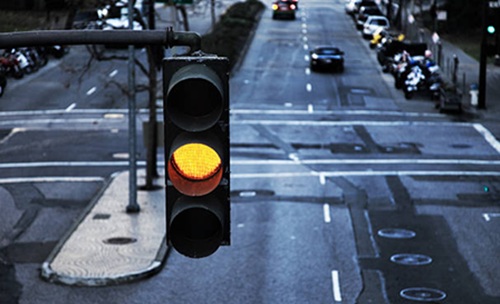Running a yellow light might seem like no big deal, but it’s actually one of the most dangerous choices you can make behind the wheel. A yellow light means “slow down and prepare to stop,” not “speed up and make it.” Pushing through can cause serious crashes, hurt people, and even get you fined.
You’re driving up to an intersection, the light turns yellow, and for a second, you think, I can make it. That one second can change everything. The car beside you might stop. The car across from you might go. And if you meet in the middle, it’s bad news.
Before you think about pressing the gas, it’s worth asking: Is it illegal to run a yellow light? The answer depends on where you are, but in many places, yes, it can be treated just like running a red light if it leads to a crash or if police decide you had enough time to stop safely.
Either way, it’s risky and can get you in serious trouble.

How Do Yellow Lights Cause Crashes?
A yellow light is meant to give drivers time to slow down, not speed up. But people often do the opposite. Some drivers see the yellow and press the gas to “beat the red.” Others think they have more time than they do. Both choices can lead to accidents.
At intersections with crosswalk timers, it’s even worse. When drivers can see the countdown, they sometimes use it as a green light to hurry through before it hits zero.
Meanwhile, people crossing the street or turning cars think it’s safe to go. When those two moments overlap, crashes happen.
T-bone crashes, i.e., crashes where the front of a vehicle collides with the side of a vehicle (making a ‘T’ shape), make up less than 10% of all car accidents in the U.S., but they cause about 20% of all traffic deaths. The sides of a vehicle just can’t absorb the same impact as the front or back.
When two cars meet at a right angle, the people inside the struck car take most of the hit.
What Are the Consequences of Running a Yellow Light?
Running a yellow light can lead to more than a crash; it can also lead to serious legal trouble. Many states treat it the same as running a red light, especially if your decision to go causes a collision. That means fines, court costs, and points on your license.
Police often write tickets for failing to stop at a yellow signal. The fine can be several hundred dollars, and in some places, it’s the same as a red-light ticket.
If there’s a traffic camera, the ticket might show up in your mailbox a few weeks later, even if no officer saw it happen.
And that’s not all. Say your yellow-light mistake actually hurts someone, be it a little or a huge injury/damage; you might end up facing civil lawsuits or insurance hikes. Also, your insurance companies may see it as reckless driving, and this can raise your rates for years before you’d be able to stabilize them again.
Quick Recap
- Yellow lights mean slow down, not speed up.
- There’s no standard yellow-light timing, so don’t assume you have time.
- T-bone crashes from yellow lights cause 20% of U.S. traffic deaths.
- Running a yellow light can lead to serious accidents, which can lead to legal and insurance complications.
- Unlike what many would like to believe, you don’t actually save time by running yellow lights.
- Always stop if it’s safe to do so; that’s what the law expects.

